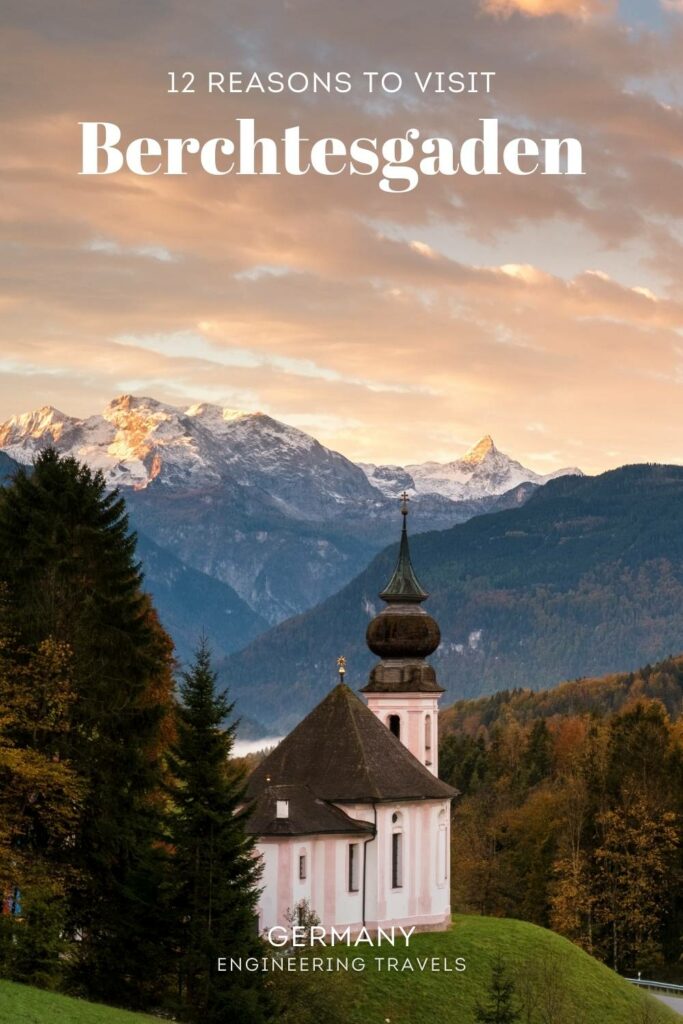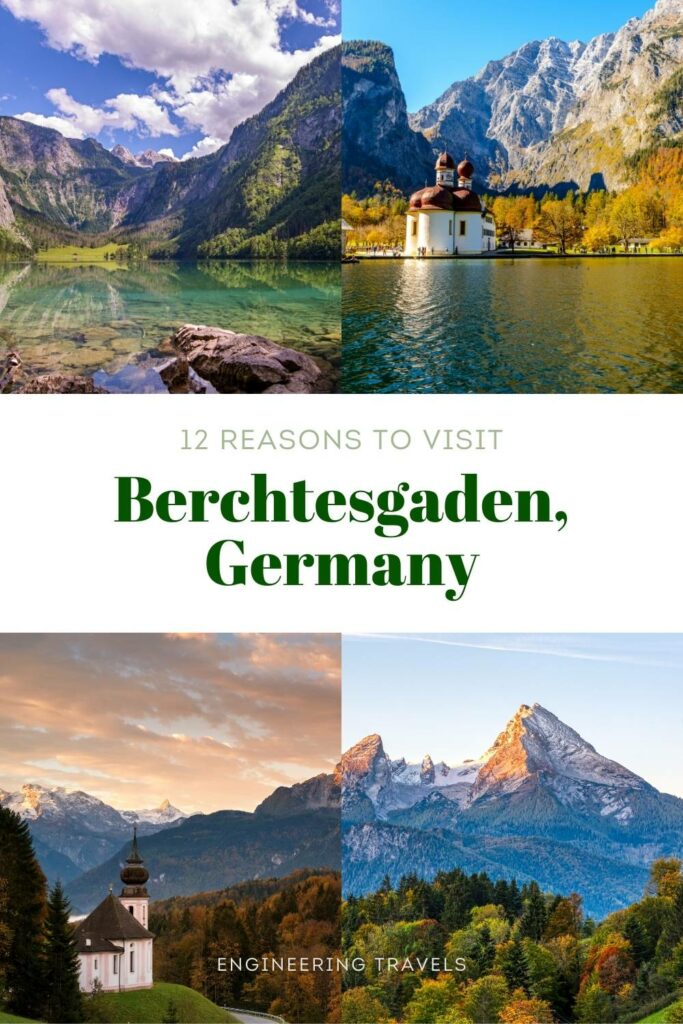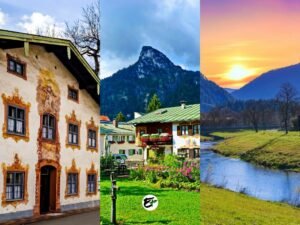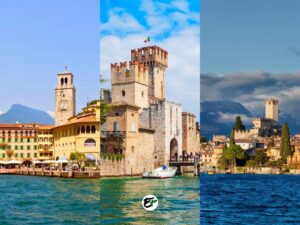Berchtesgaden Travel Guide: 12 Highlights and Essential Tips
Do you agree that Bavaria has the most beautiful places in Germany? Maybe you do, maybe you don’t. But I’m sure you’ll be impressed by Berchtesgaden, one of the gems of this state in Germany.
Berchtesgaden is a destination in Germany that deserves your attention. Located in the Bavarian Alps, it is surrounded by stunning natural scenery that will fill your camera with amazing photos and your mind with memorable experiences with nature.
If you’re curious about what makes Berchtesgaden a must-see place, in this post, I’ll highlight the unique features of Berchtesgaden and the advantages of visiting this wonderful location. Most importantly, should you decide to visit, this post can serve as your comprehensive guide.
This post contains affiliate links. I may receive a tiny commission at no additional cost to you.
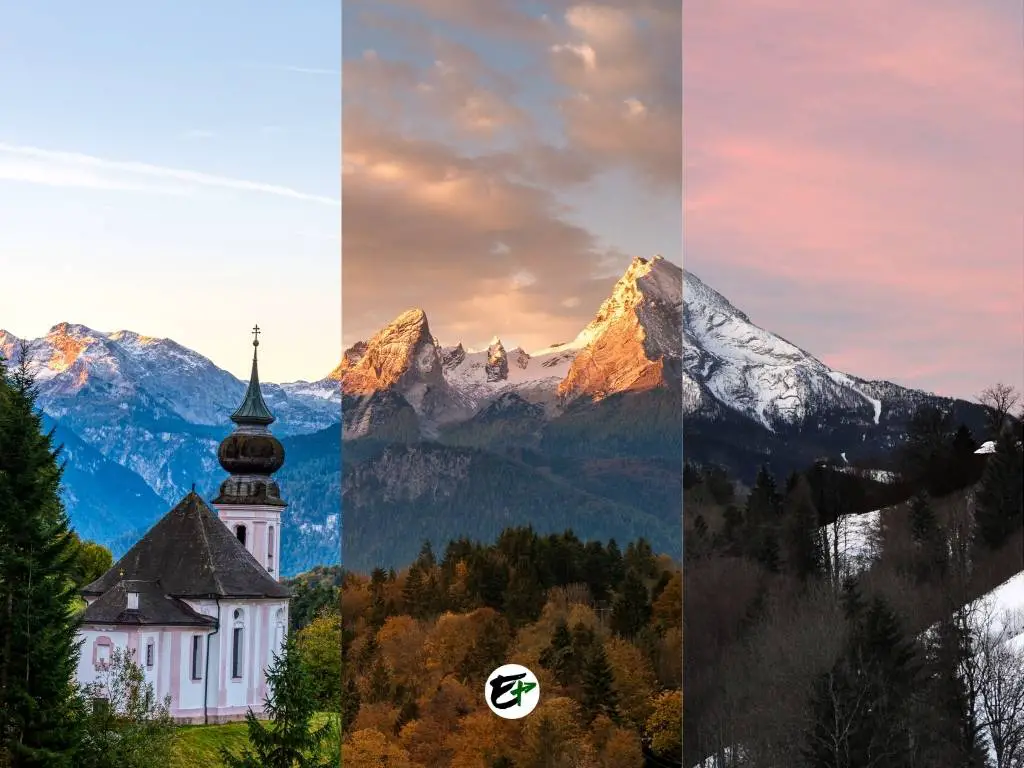
Use the table of contents to skip to topics.
Traveling is all about unwinding, having a blast, making memories, admiring the beauty of nature, and personal growth. I feel these emotions every time I explore places with breathtaking natural landscapes, particularly mountainous regions.
If you’re like me, Berchtesgaden won’t disappoint you. It’s a place where the stunning beauty of nature will leave you in awe and make your journey truly memorable.
Although there are many other places in Europe that offer similar experiences, such as the Swiss Alps, Chamonix in France, Cortina d’Ampezzo in Italy, and other Bavarian towns and villages, Berchtesgaden has a unique charm that sets it apart from the rest. It is an unmissable destination if you are traveling in southern Germany and central Europe.
Let me show you… (you must also see the 10 Viewpoints & Scenic Spots in Berchtesgaden)
1. Berchtesgaden’s Accessible Location
If you look at a map of Germany alone, Berchtesgaden will make you think that it takes a lot of time and effort to reach. Located in the southeasternmost part of the country, surrounded by mountains, and a few hundred kilometers away from Berlin, it certainly seems that way.
However, don’t be fooled into thinking that it’s difficult to get to. When compared to other similarly beautiful places, Berchtesgaden’s accessibility is definitely a reason to pay a visit.
Even though Berchtesgaden is situated on the outskirts of Germany, it’s only 154 kilometers away from Munich – a quick and easy 2-hour drive. But what’s even more convenient is that it’s just 26 kilometers away from Salzburg, Austria, which takes only 45 minutes to get to by car or bus.
If you’re not keen on driving and are starting your journey from Munich, taking the train would be your best bet. Although it takes 2 and a half hours and requires 1 transfer, it’s a stress-free and comfortable way to get to Berchtesgaden.
However, during the peak season, finding a parking spot in Berchtesgaden can be a hassle, so opting for the train instead of renting a car is recommended. If you’re traveling from Salzburg, the best and quickest option is the bus (bus no. 840). It provides a direct connection between Salzburg and Berchtesgaden, and is around 20 minutes faster than the train.
Interested in more beautiful destinations in southern Germany or amazing places to visit in the Bavarian Alps aside from Berchtesgaden? There are many you can choose from. In Bavarian Alps, there’s Mittenwald and Neuschwanstein Castle. If you’re coming from Nuremberg or Munich, you can have a day trip to Rothenburg ob der Tauber, Bamberg, or Wurzburg. Moving westward, you can find Stuttgart, the Black Forest, and Lichtenstein Castle.
2. Salt Mine Berchtesgaden
Among the qualities that travelers search for in a new destination, uniqueness is often at the top of the list. If you’re curious about what makes Berchtesgaden different from other towns and nature destinations, the answer lies in its salt mine.
For centuries, the people of Berchtesgaden have been mining salt, and it’s a part of their town’s identity that dates back many years ago. In the early 16th century, a salt mine was established in Berchtesgaden, and it still stands as Germany’s oldest active salt mine to date.
Through the years, the salt mine’s operations have evolved, never once interrupted. The salt mine has become one of Berchtesgaden’s top tourist destinations. And now it is the second reason why you should visit the town. The adventure into a salt mine combined with the breathtaking scenery of the Bavarian Alps is the unique experience package Berchtesgaden has to offer you.
Berchtesgaden’s Salt Mine is like no ordinary salt mine. It is a whole new world underneath. Fun, learnings, and entertainment await you inside. Visiting Berchtesgaden Salt Mine is a tour to bring you 650 meters into the mountain. You will be taken to a salt cathedral, a stone salt cave, and a salt laboratory. It ends with an epic, otherworldly rafting on a salt lake reflecting the cave’s ceiling.
This activity is one for the family, actually! Adults will learn so much about making salt process and the machines. Kids? They will enjoy the slides and trains. Young and old will be fascinated by the laser shows and spectacles seen underneath the earth.
The tour inside the salt lake lasts approximately one hour. However, you should allow additional 30 minutes to one hour to line up, change clothes, and return the miner’s clothes.
Berchtesgaden Salt Mine tours run every 10 minutes from 9:00 am until 4:30 pm, April to October. Then, every 25 minutes from 11:00 am to 3:00 pm, November to March. The salt mine is closed on holidays. Don’t forget to check Berchtesgaden Salt Mine’s Website for announcements before you visit. You can get your skip-the-line tickets below:
3. Historical Landmarks in Berchtesgaden
The Salt Mine discussed previously gives visitors insights into Berchtesgaden’s centuries-old industry in a fun and enjoyable way. It is one of the two unique things you can find in Berchtesgaden. The other one is Eagle’s Nest, and it’s absolutely another reason to visit Berchtesgaden.
So, what exactly is the Eagle’s Nest?
Once used as a meeting place for the Nazi Party’s social and government events, Eagle’s Nest in Berchtesgaden is a historically significant site. Its name originated from a French ambassador’s description of the location resembling an eagle’s nest during a rare diplomatic meeting with Hitler.
Set atop a mountain, Eagle’s Nest offers visitors breathtaking views of the Bavarian Alps, making it a truly unforgettable experience.
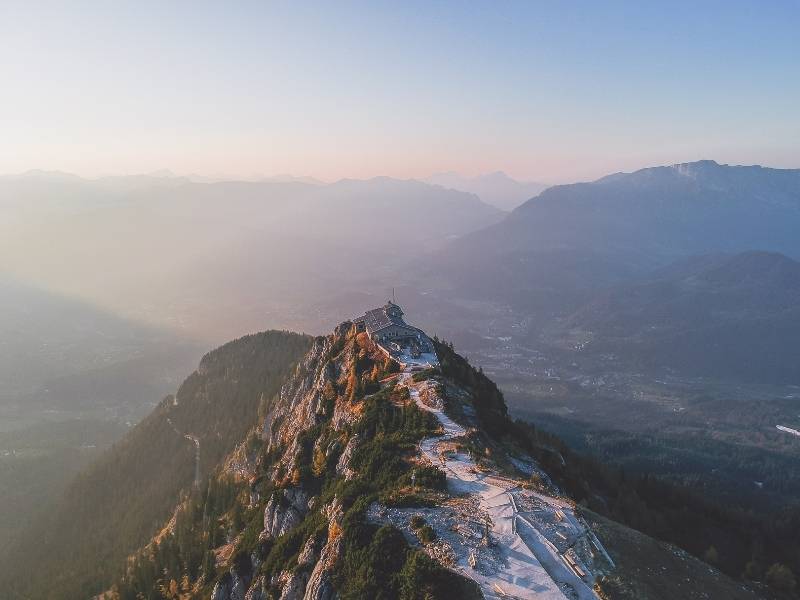
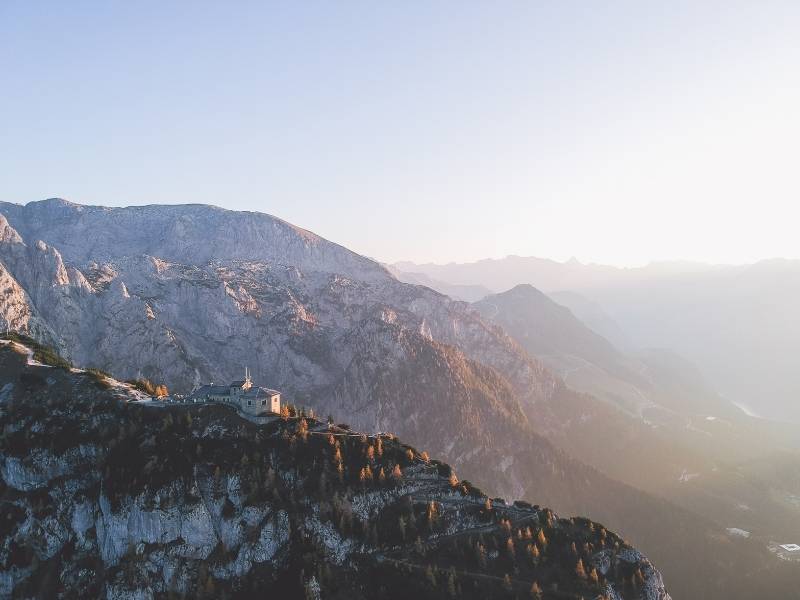
The Eagle’s Nest was converted into a restaurant with a beer garden after the war. Come and eat here so both your eyes and tummy will be satisfied!
From the heights of the Hoher Goll mountains, at 1,834 meters above sea level, Eagle’s Nest offers stunning views of the surrounding landscapes. You can gaze at Jenner, Konigsee, Berchtesgaden, and Salzburg from this vantage point. But Eagle’s Nest is more than a scenic spot.
It also features a golden brass elevator that takes you 124 meters up, a historic fireplace, graffiti left by Allied soldiers, and Hitler’s small study room.
There are two ways you can reach Eagle’s Nest from Berchtesgaden, hiking and bus ride. Although Eagle’s Nest is linked to the town with roads, only public transportation is allowed to use them. So, if you have a car, you have to park and leave it at the Busbahnhof Kehlsteinhaus, and from there, take the bus to reach Eagle’s Nest.
Anyhow, here’s a list of guides and tours which can help you visit Eagle’s Nest:
4. Berchtesgaden’s Breathtaking Mountain Views
Berchtesgaden is a paradise for mountain lovers, surrounded by mountains such as Hochkalter, Wattzman, Jenner, Untersberg, and many more. The pacifying sights are everywhere and are reason enough to visit.
If you seek peace of mind and want to breathe new life into yourself, then Berchtesgaden is the place to be. The stunning scenery of the mountains starts on the road to Berchtesgaden from either Salzburg or Munich. As you come closer and closer to Berchtesgaden, the scenery gets better and better.
You’ll pass alpine meadows and thick forests – pictures of life that people who have had enough of living in an exhausting city or bustling concrete jungle hardly desire.

If you’re traveling in summer, you can totally immerse yourself in the mountains by going to Berchtesgaden National Park.
With more than 260 kilometers of hiking trails, hikers of all ages and skill levels will find a trail that suits them. For those looking for a more daring adventure, try one of the Via Ferrata routes!
Berchtesgaden National Park also boasts 26 mountain huts and alpine pastures, each offering a peaceful retreat and delicious, hearty meals. You can learn more about the park’s hiking trails, flora, fauna, and history through this flyer from Berchtesgaden National Park.
Not everyone is a fan of hiking or may not have the opportunity to do so. However, this doesn’t mean you have to miss out on the spectacular mountain views that Berchtesgaden has to offer. With various facilities and services available, you can easily reach some of the most scenic locations in just a matter of minutes. The Eagle’s Nest, discussed earlier, is one such location.
Another option is the Jenner Aussichtsplattform, which can be reached via cable car from Schönau am Königssee, a neighboring town located to the south of Berchtesgaden.
Located within the Goll Massif, Jenner is a mountain peak that has become a renowned skiing and hiking destination for both tourists and travelers over the years. Standing tall at 1,874 meters above sea level, Jenner offers a stunning view of the Watzmann Massif, with a bird’s eye view of Konigsee below.
If the weather permits, visitors can also witness a stunning sea of clouds that often blankets Konigssee and Schönau, making for a surreal and otherworldly experience that feels like a glimpse of heaven.
5. Blissful Lakes in Berchtesgaden
One reason to visit Berchtesgaden is that it offers a wonderful combination of natural attractions. As an alpine destination, you can enjoy the majestic mountains as well as the serene lakes.
Berchtesgaden has many lakes, some of which are hidden in the mountains and some of which are easily accessible from the town.
The three main lakes are Konigsee, Obersee, and Hintersee. They are all different and beautiful in their own ways, but Konigsee is the most well-known and crowded one because it is easy to reach and has interesting stories.

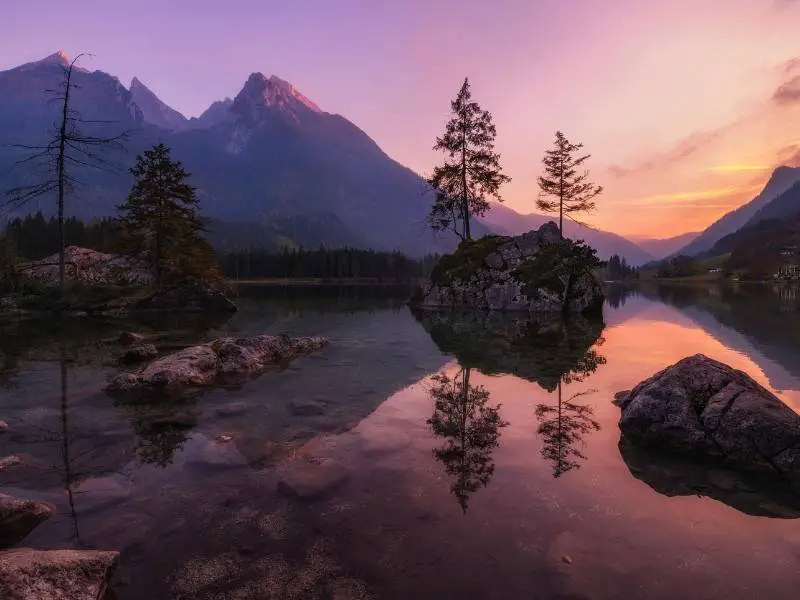

You might be surprised to learn that the water of Konigsee is almost as pure as drinking water. For more than a century now, only battery-operated boats have been allowed to transport people across the lake to avoid oil spillage and cause damage. The scenery on the boat, from Konigsee’s glittering crystal clear water to lush pine trees and spectacular mountains, is absolutely remarkable.
The “longest” mountain face in the Eastern Alps, Watzmann’s, can be seen while on the boat traversing the lake from north to south. The boat ride in Konigssee starts in Schönau, the village north of the lake. It has three stops before it completes the round trip.
Disembark at the Hirschau peninsula to visit the Saint Bartholomew Church, Kassel to visit a small Alpine Pasture, and Salet to another lake called Obersee.
Obersee is the second most beautiful lake you can visit from Berchtesgaden. It’s located near the southern shores of Konigssee, a few-minute hike after you disembark from the boat in Salet.
Though Obersee is 10 times smaller than Konigssee, Obersee’s appearance would set you on a picture-taking spree. It’s encircled by mountains, and the lake’s calm and crystal clear water creates a mirror view of these mountains. Staring at Obersee would seem like a look into a portal to another dimension.
The third lake is called Hintersee, and it’s Berchtesgaden’s another picture-worthy destination 12.9 kilometers away from the town.
Since 1850, this lake has been a source of inspiration for thousands of artists and photographers. It mirrors the Watzmann massif, forming a stunning postcard scene. It is often referred to as the ultimate romantic lake.
6. Berchtesgaden has Picturesque Chapels and Churches
If you like to take photos and share them with the world, you will love Berchtesgaden. The lakes are amazing, but they are not the only places that will impress you.
Berchtesgaden also has churches that are situated in beautiful and photogenic locations. Here are three churches that you should not miss: the church of Saint Bartholomew, Wallfahrtskirche Maria Gern, and the Parish Church of St. Sebastian.
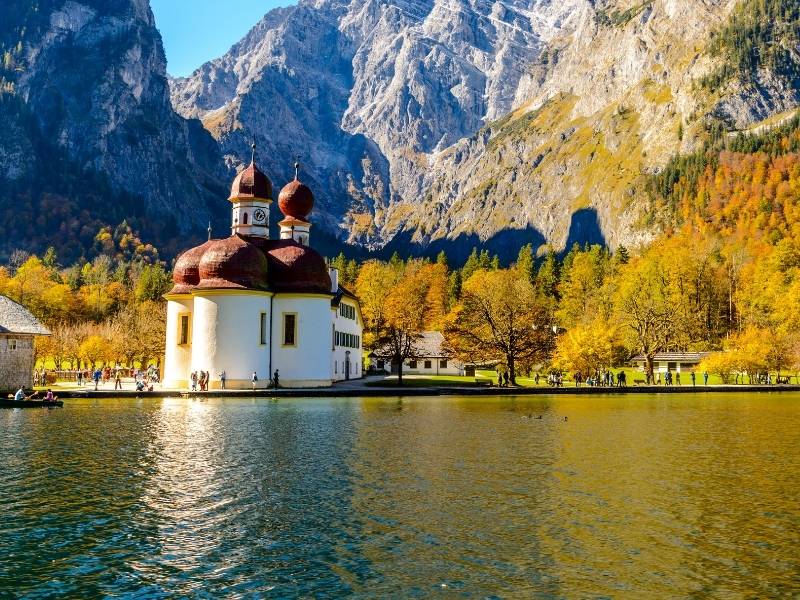

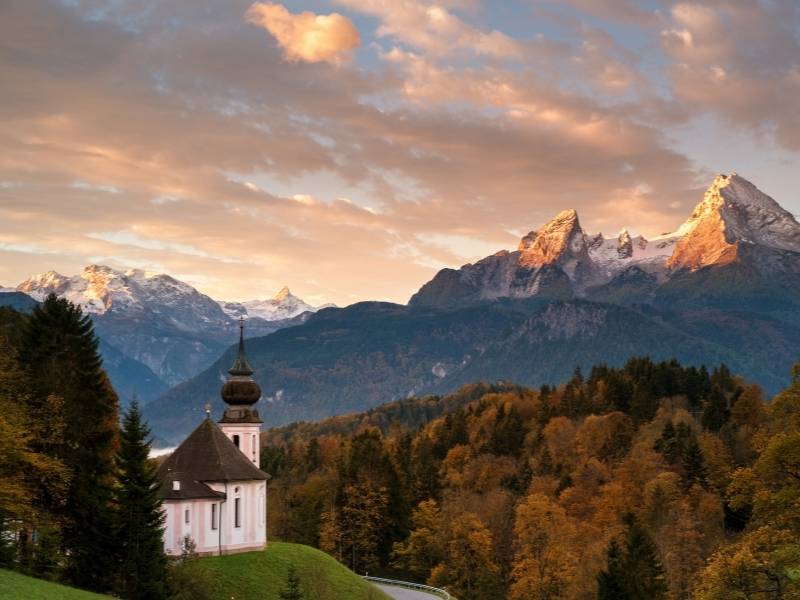
When you travel, you sometimes find unexpected gems like these churches in Berchtesgaden. They make your trip more enjoyable and memorable, no matter if you are a wanderer, a hiker, or an explorer.
The most famous church among the three churches I mentioned was built in Konigssee’s Hirschau peninsula. It is called the Church of Saint Bartholomew, and it’s the little church perched beside a lake that we often see on social media’s travel pages and groups about Germany.
The Church of Saint Bartholomew is a sight to behold in Berchtesgaden. Its white walls and red onion domes contrast beautifully with the clear water of Konigssee, creating a stunning reflection. The church looks like something out of a fairytale, especially with the majestic Watzmann mountain looming behind it.
The Church of Saint Bartholomew is also a Roman Catholic pilgrimage church dating back to the 12th century. If you visit Berchtesgaden on the Saturday after the 24th of August, you might see pilgrims who have crossed the Berchtesgaden Alps all the way from Maria Alm in Austria.
The Parish Church of St. Sebastian is much easier to visit than the Church of Saint Bartholomew. It is located in Ramsau, on the way to Hintersee, and you don’t need a boat to get there. Just take bus no. 846 from Berchtesgaden central station and you will arrive in 20 minutes.
Though the Parish Church of St. Sebastian was not built beside a lake, it has a river near it. The mountains are also in their backdrop. A quick stop at the church is a glimpse into the beautiful German countryside in the alps.
Wallfahrtskirche Maria Gern is the third church in Berchtesgaden. It is in a small village called Maria Gern, north of the town. The village is at the foot of Kneifelspitze, a mountain with amazing views of Berchtesgaden and the Watzmann massif. Perched on a hill, surrounded by thick forest, and with the image of Watzmann mountain in the backdrop, this quaint church has everything to make itself straight out of a fairytale.
If you head a little north of the Wallfahrtskirche Maria Gern, you’ll find the perfect spot to snap a picture of the church and the iconic saddle created by the peaks of the Watzmann massif.
The church’s white walls provide a stunning contrast to the breathtaking scenery around it, making it a must-see for any photography enthusiast. To get to Maria Gern, all you need is to get to Berchtesgaden Rathaus (town hall) and catch a ride on bus 837.
You shall arrive at Maria Gern in less than 10 minutes after the bus departs the town hall. The bus leaves the town hall every hour.
7. Germany’s Tallest Waterfall is in Berchtesgaden
Berchtesgaden has the most spectacular mountains, beautiful lakes, and picture-worthy chapels in Germany.
But the list of beautiful places does not end there. Berchtesgaden has more natural wonders you must discover, and they’re a reason to be in Berchtesgaden. One of them is the Rothbach waterfall, situated near Obersee. It’s the gorgeous white line you’ll find on the corner of the valley where Obersee is.
Cascading from a 470-meter cliff, Rothbach is considered the tallest waterfall in Germany.
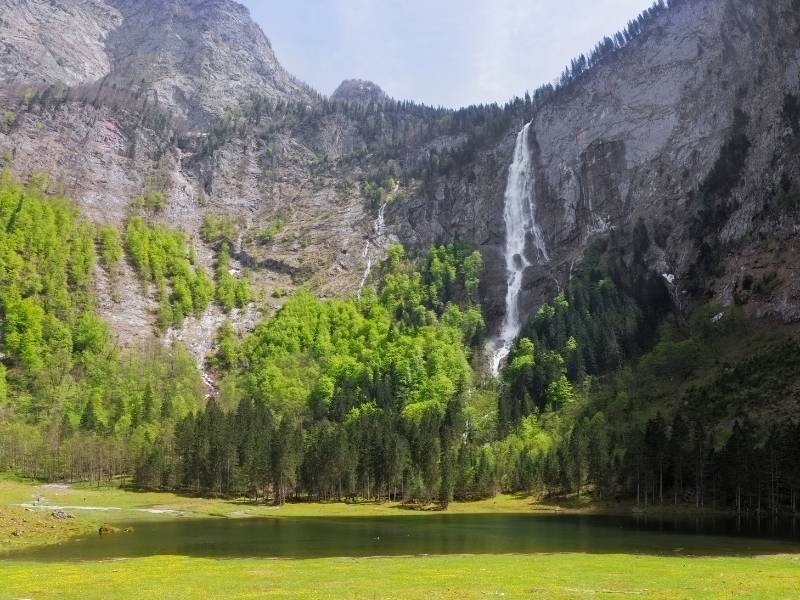
Rothbach waterfall is pretty isolated compared to the destinations mentioned previously. This is why many people, including myself, are unaware of Rothbach waterfalls and think it’s the Triberg waterfall in the Black Forest as the country’s tallest. There are two ways you can get to Rothbach waterfalls. You can either hike from Jenner or take a boat ride in Konigssee and hike to it.
8. The Beautiful Gorge in Berchtesgaden
Previously, I mentioned that Berchtesgaden is a worthy package deal destination you must visit.
Aside from graceful waterfalls, fairytale lakes, and stunning mountains, you can also see a gorge in Berchtesgaden that is still a work in progress yet already a masterpiece of nature. The name of the gorge in Berchtesgaden is Wimbachklamm. This 200-meter-long gorge is the eighth reason you should visit Berchtesgaden.
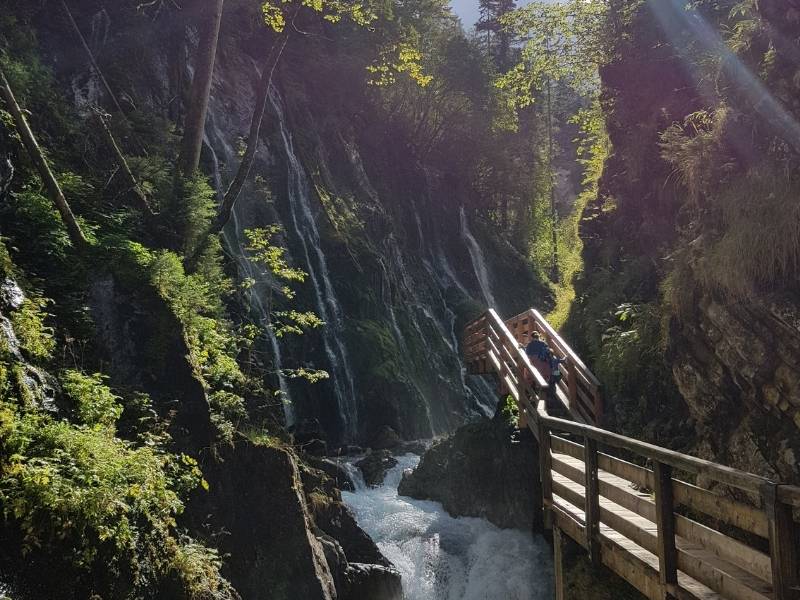
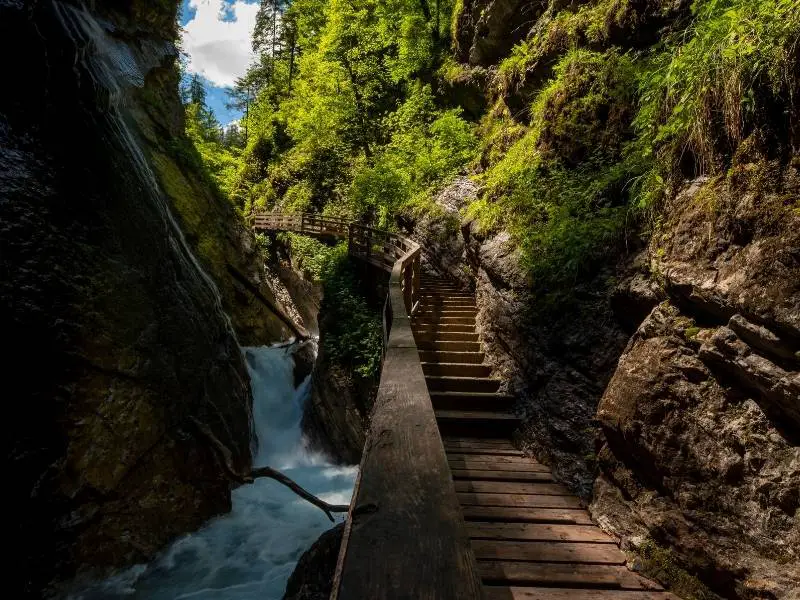
Visiting Wimbachklamm is a visit to some of nature’s spectacular works of art. It has wooden pathways to bring you to different rock formations with water flowing out. Some rocks even have fossils dating from the Late Triassic period!
Wimbachklamm is another fantastic immersion in nature, I would say. You’ll be amazed by the milky blue water flowing in the middle of the gorge. Somehow it soothes us inside through the thundering sound they create.
If you are staying in Berchtesgaden for days, I suggest that you visit Wimbachklamm together with Hintersee and the Parish Church of Saint Sebastian. These three destinations are serviced with the same bus following route 846.
9. Berchtesgaden’s Spectacular Ice Cave
If you love exploring natural wonders during your travels, the Ice Chapel is another interesting destination in Berchtesgaden.
It’s not a church, but a rare and breathtaking natural phenomenon that showcases the another beauty of nature. So, what is Ice Chapel all about? Ice Chapel is the lowest-lying snowfield in the alps.
Situated at only 800 to 1000 meters above sea level, it is incredibly existing below the freezing altitude of 2000 meters.
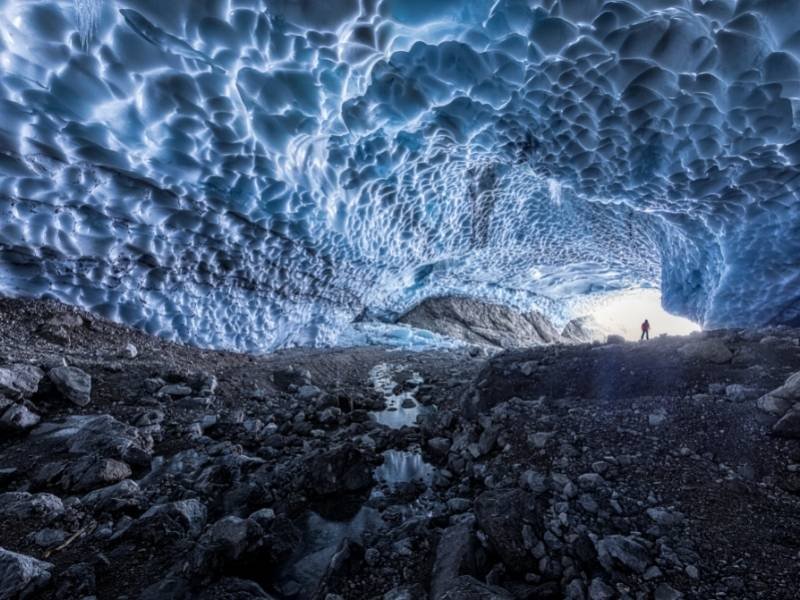
Ice Chapel is frozen all year round, even during the summer. However, it is not yet considered a glacier but is still just firn. Firn is the intermediate stage before the snow completely turns into a glacier.
Though it looks like an ordinary block of ice forming an ice cave from afar, the “real” spectacle is seen when you come closer and enter. It’s an otherworldly scenery – so overwhelmingly unbelievable to see.
Going inside Ice Chapel is like entering a cave, but instead of rocks and soil above and beside you, you’ll see carved ice of different shapes forming irregular blue lattices. However, it is recommended that you go deep inside Ice Chapel as it is always on the verge of collapsing due to the warming climate.
Be cautious when going inside.
The way to the Ice Chapel starts in Konigssee on Hirschau Peninsula. From there, you’ll find a hiking trail leading to the Ice Chapel. The hiking trail to the Ice Chapel is about 3.3 kilometers long, or a 1.5-hour trek.
10 . Watzmann Therme Berchtesgaden
Visiting Berchtesgaden is also about improving your overall well-being, not only having fun in adventures and filling yourself with awe, which by the way, is good for our physical and mental health.
I’ll tell you how later on, but certainly, it is enough to be considered another reason you should visit Berchtesgaden. With everything that we discussed previously, I know that you already know that visiting Berchtesgaden may involve lots of adventurous activities like hiking and lots of exploring. Though it’ll be fun and unforgettable, tiredness after is definitely inevitable.
Imagine spending all day in the mountains and lakes, hiking for hours, and visiting natural wonders. I’m sure your feet will hurt. Honestly, that’s one of my problems every time I travel!
If you’re visiting Berchtesgaden and planning to do all exciting yet energy-demanding activities, you have an incredible option to relax after. Check out Watzmann Therme, Berchtesgaden’s thermal spa that is great for all ages and best for family travelers. Well, Watzmann Therme is not only a spa but an overall wellness center.
It offers a wide range of facilities which everyone can enjoy. Additionally, you can see lovely scenery as you relax in their wellness facilities. Watzmann Therme offers pools designed for sports, fun 80-meter waterslides with light effects, themed saunas, brine pools, massages, and many more!
Learn more about Watzmann Therme from their official website.
11. Scenic Drives in Berchtesgaden
In the beginning, I said it’s preferable to use public transportation more than renting/bringing your own private vehicle when visiting Berchtesgaden – all because of the limited parking space.
But it is not the case if you’re traveling during non-peak season. It’s better to rent/bring a car to be more flexible with your time. But most importantly, you will choose to drive because Berchtesgaden has scenic roads that await you. The experience of driving on such beautiful roads is another reason you should visit Berchtesgaden.
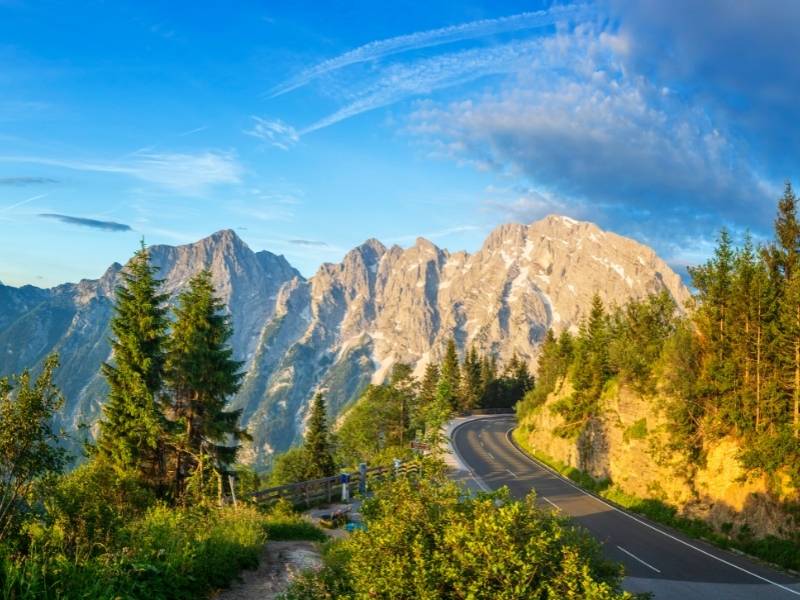
Situated in the alps, one of the most beautiful regions of the world, you are guaranteed that the roads to and within Berchtesgaden have scenery you won’t regret seeing. If you’re planning a road trip in Berchtesgaden, there are two routes that are worth considering. The first is the Rossfeld Panoramic Road. The second is the German Alpine Road.
The Rossfeld Panoramic Road lies northeast of Berchtesgaden, near the German-Austrian border. It is Germany’s highest panoramic road. Here, you’ll witness the breathtaking scenery of the Berchtesgaden Alps, overlooking Salzburg and Salzach Valley.
On the other hand, the German Alpine Road, the oldest tourist route in the German Alps, is located west of Berchtesgaden. German Alpine Road is the road that links Berchtesgaden with Germany’s largest lake, Bodensee, in southwestern Bavaria. This beautiful road passes through the charming towns in the region, such as Oberammergau and Garmisch Partenkirchen.
If you plan to see more beautiful parts of the Bavarian Alps by car, this is just the way you must take.
12. The Beautiful Bavarian Culture in Berchtesgaden
The last reason to visit Berchtesgaden is the Bavarian Culture. Starting from quaint preserved towns and adorable houses to festive beers festivals and so on – they will just fascinate you I believe! We can start with the culture embedded in the streets of Berchtesgaden.
You would not believe how charming Bavarian towns are. A visit to each is like going inside a colorful book and marveling at the beautiful artwork.
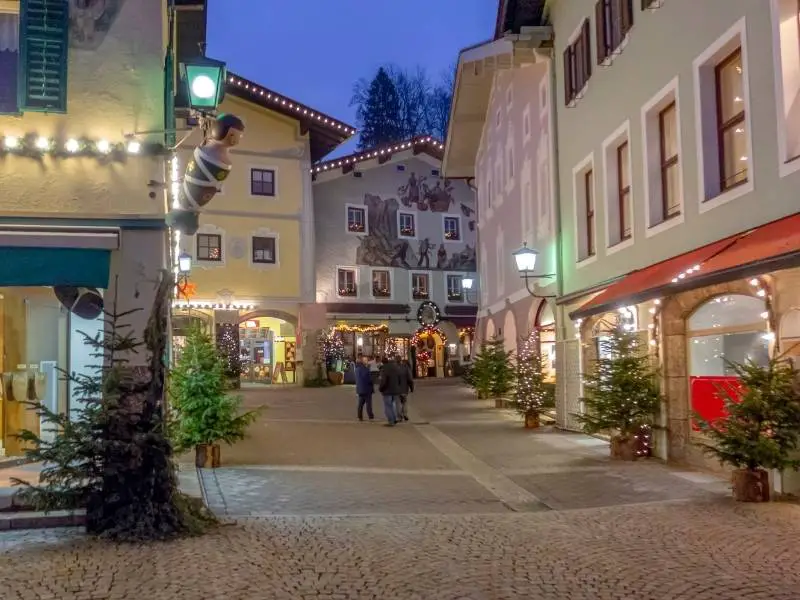
Houses in a Bavarian town like Berchtesgaden have Luftmalerei in their facades. They are beautiful and colorful murals that depict various things, from biblical stories to the patron saints of houses and the livelihood or work of the house owner.
Because of Luftmalerei painted in the houses, these Bavarian towns are now like open museums where you discover new things and culture by just leisurely strolling around. Most Luftmalerei applies trompe-l’œil style, making the townscape even more captivating.
What’s more compelling about visiting Berchtesgaden? It has numerous engaging cultural events spread all over the year. To witness them is such a memorable experience. Here is the calendar of events to learn more.
When to Visit Berchtesgaden
If you are planning to visit Berchtesgaden, you might be wondering when is the best time to go. Well, the answer depends on what you want to see and do in this charming town.
Consider The Season
Berchtesgaden has something for everyone in every season, but each season also has its own advantages and disadvantages. Let me tell you more about them.
Spring
Spring (March to May) is a lovely time to visit Berchtesgaden, as the weather is mild and the flowers are in bloom. You can enjoy the fresh air and the green landscape, and explore the town and its surroundings. You’ll love the view when exploring and hiking to the small churches and nearby hiking destinations.
The average temperature is between 6°C and 16°C (43°F and 61°F), and the rain is not too heavy. However, if you want to visit some of the attractions that are located at higher altitudes, such as the Eagle’s Nest, you might be disappointed, as they may still be closed or covered by snow.
You might also encounter some crowds during Easter and other holidays, so book your accommodation and tickets in advance.
Summer
Summer (June to August) is the most popular time to visit Berchtesgaden, as many people come to enjoy the warm weather, the stunning scenery, and the outdoor activities. You can hike, bike, swim, kayak, or just relax by the lake or in the park. The average temperature is between 15°C and 23°C (59°F and 73°F), and the sun is shining most of the time.
You can also expect longer opening hours for most of the tourist attractions, so you can see more of them.
However, summer also means higher prices and longer queues, as this is the peak season for tourism. You might also want to avoid visiting in July and August, when many Germans take their summer vacations and the town gets very busy.
Autumn
Autumn (September-November) is a great time to visit Berchtesgaden if you love the colors of fall and the festive atmosphere. You can admire the changing leaves and the golden light, and experience some of the traditional festivals that take place in this season, such as Oktoberfest and Trachtenfest.
The average temperature is between 9°C and 18°C (48°F and 64°F), and the rain is minimal. However, as autumn progresses, some of the tourist attractions may start to close or have shorter opening hours, so check before you go. You may also encounter some cold and rainy days, especially in November, so pack some warm clothes and an umbrella.
Winter
Winter (December-February) is a magical time to visit Berchtesgaden if you are a fan of winter sports, Christmas markets, and cozy atmosphere. You can ski, sled, ice skate, or snowshoe in the nearby mountains, or visit the historical sites and museums in the town.
The average temperature is between -1°C and 4°C (30°F and 39°F), and the snow is moderate.
You can also enjoy the festive decorations and lights, and shop for gifts and souvenirs at the Christmas market. However, some of the tourist attractions may be closed or inaccessible due to snow, so plan your itinerary accordingly. You may also need to pack warm clothes and be careful of icy roads.
Consider the Events
If you want to have a memorable time in Berchtesgaden by attending some of its cultural events, here are some of my recommendations:
- Fasching Festival (February): This is a carnival celebration that happens before Lent. You can join the fun by dressing up in a colorful costume, mask, or hat, and watching or participating in the parade that goes through the streets. You can also enjoy some local food and drinks, such as sausages, pretzels, beer, or schnapps.
- May Day Celebration (May 1st): This is a spring festival that celebrates the fertility of nature. You can watch a large maypole being erected in the town square, decorated with wreaths and emblems. You can also see people dancing around it with music and beer.
- Great Bavarian Evenings (Mondays in Summer): This is a weekly event that showcases the local folklore and traditions of Berchtesgaden. You can watch men performing thigh-slapping dances called Schuhplattler , listen to brass band music, and join a live DJ party.
- Trachtenfest (2nd Sunday of July): This is a festival that preserves the authentic dress and customs of Berchtesgaden. You can watch a large parade of people wearing traditional outfits, carrying flags and banners, and shooting guns. You can also attend a church service and a beer hall party afterwards.
- Almabtrieb (End of September): This is also a festival that marks the end of the summer grazing season for the cows. You can watch a parade of cows decorated with flowers, bells, and ribbons being led down from the pastures to their winter stables. You can also enjoy some local food and drinks along the way.
- Buttnmandl and Krampus (December 5th): This is another festival that features two mythical creatures that accompany St. Nicholas on his visit to children. The Buttnmandl are men wrapped in straw who make loud noises with whips and bells, while the Krampus are men dressed in fur and horns who scare naughty children with chains and sticks. You can watch them run from house to house or join them if you dare.
- Christmas Market (December): This is a festive market that takes place in the town square during Advent. You can browse through various stalls selling handicrafts, ornaments, candles, toys, and other gifts. You can also taste some delicious food and drinks, such as mulled wine, gingerbread, roasted chestnuts, and sausages.
Here’s the calendar of events in Berchtesgaden.
Consider the Budget
If you are looking for a budget-friendly trip to Berchtesgaden, you might want to consider visiting in the fall season, from September to November.
This is when the hotel prices are the lowest, averaging $191 per night (Average of budget, mid, and high end hotels as of 2023). That’s a huge saving compared to the summer season, from June to August, when the hotel prices are the highest, averaging $264 per night. You can save up to 28% on accommodation costs by choosing the fall season over the summer season.
Here’s where you can find the best accommodation deals in Berchtesgaden.
How Long to Stay in Berchtesgaden
Berchtesgaden is a beautiful place to visit in Germany, with many attractions and activities to enjoy. Depending on how much time you have and what you want to see, you can plan your trip accordingly.
My Bavarian Alps itinerary can also help you decide how long you must stay in Berchtesgaden:
Here are some suggestions for how long to stay in Berchtesgaden based on your preferences.
One Day in Berchtesgaden
One day is enough to see the highlights that are accessible right from the town.
If you only have one day, you can start your day by going to the Eagle’s Nest, enjoy the breathtaking views of the Alps and learn more about the history of Nazi Germany at the Documentation Center.
You can also explore the underground bunker system that was built for Hitler and his associates. After lunch, you can head to the Salt Mine Berchtesgaden, where you can join a guided tour of the ancient salt mine. You can see how salt was extracted and transported for centuries, and even slide down some of the tunnels.
You can end your day by walking around the old town of Berchtesgaden, where you can admire the traditional architecture and taste some local specialties, such as windbeutels or schnitzel.
Alternatively, you can do a little hike or quick visit to the picture-perfect churches around the town.
Three Days in Berchtesgaden
If you have more time and want to see everything that Berchtesgaden has to offer, you can spend at least three days in this region.
Besides visiting the Eagle’s Nest and the Salt Mine Berchtesgaden, you can also go to the Konigssee, which is a stunning lake surrounded by mountains. You can take a boat ride on the lake and stop at the St. Bartholomew’s Church, which is a cute chapel on a small peninsula.
You can also hike to some of the nearby waterfalls and viewpoints, such as the Obersee.
Another day, you can take the Jenner cable car to the top of the Jenner mountain, where you can have a panoramic view of the Berchtesgaden National Park and the Watzmann massif. You can also ski or snowboard on the slopes in winter or hike on the trails in summer.
Finally, you can visit the Wimbachklamm and walk along a wooden path that follows the water and admire the natural beauty of the rocks and waterfalls.
Decide How Long in Berchtesgaden
If you want to decide for yourself how long to stay in Berchtesgaden, here is some information about how much time most tourists spend on each attraction in Berchtesgaden:
- Eagle’s Nest: Most tourists spend about 2 to 3 hours at the Eagle’s Nest. This includes the bus ride from Obersalzberg to the parking lot, which takes about 20 minutes each way, the elevator ride to the summit, which takes about 4 minutes each way, and the time spent at the restaurant and observation deck.
- Salt Mine Berchtesgaden: Most tourists spend about 2 hours at the Salt Mine Berchtesgaden. This includes the guided tour of the mine, which lasts about an hour, and some extra time for browsing the souvenir shop and taking photos.
- Konigssee: Most tourists spend about 4 to 5 hours at the Konigssee. This includes the boat ride from Schönau am Königssee to St. Bartholomew’s Church and back, which takes about an hour each way, and some time for exploring the church and hiking around the lake.
- Jenner: Most tourists spend about 2 to 3 hours at the Jenner. This includes the cable car ride from Schönau am Königssee to the summit station and back, which takes about a few minutes each way, and some time for enjoying the views and activities at the top.
- Wimbachklamm: Most tourists spend about 2 to 2.5 hours at the Wimbachklamm. This includes the walk from Wimbachbrücke to the entrance of the gorge and some time for walking through the gorge and admiring the scenery.
Where to Stay in Berchtesgaden
Where should you stay when you visit Berchtesgaden? Here are some pros and cons of different options.
Here’s where you can find the best hotel deals in Berchtesgaden.
Staying in the town
This is a great option if you want to be in the heart of the action.
You can walk to the main attractions, such as the salt mines, the royal palace, and the documentation center. You can also find many shops, restaurants, and public transport options easily accessible in the town center. The downside of staying in the town is that it can get noisy and crowded, especially during peak seasons.
You may also not get the best views of the scenery that you can get from higher altitudes.
Staying on the outskirts
Picking a hotel outside the town is a good option if you want a more peaceful and relaxing stay. You can enjoy breathtaking views of the mountains and valleys, and breathe in the fresh air. Some areas (example, Schönau) even have quicker access some of the hiking trails and cable cars that take you to higher peaks, such as Jenner.
Staying in Schönau also gives you closer access to Konigssee and Wimbachklamm.
The downside of staying on the outskirts is that you may need a car or a bus to get to the town center and other attractions. You may also pay more for accommodation and food than in the town.
Should I have a day trip Instead?
This is an option if you are short on time or budget.
You can still see some of the highlights, such as Königssee and The Eagle’s Nest, and get a taste of the local culture and cuisine. You can also save money on accommodation (more options) and transportation by staying in a bigger city with more options, such as Munich or Salzburg.
The downside of making a day trip is that you may not have enough time to fully appreciate all that Berchtesgaden has to offer. If you don’t have an accommodation to stay yet, this hotel finder offers the best hotel deals in Berchtesgaden and nearby areas.
How to Get Around Berchtesgaden
If you want to visit different places in Berchtesgaden, you have plenty of choices for transportation. You can take a train, a bus, a car, or a bike. Here are some details about each option:
- Train: The Berchtesgadener Land Bahn (BLB) is a local train that connects Berchtesgaden with other nearby towns and cities, such as Freilassing, Bad Reichenhall, and Salzburg. You can bring your bike on the train for free.
- Bus: With the Berchtesgaden guest card, you can ride most bus routes in the region for free. You just need to show your card to the driver when you board the bus. You can also use the RufBus, which is a special bus service that you can order by phone two hours before you need it. Another option is the Alpine Experience Bus (ALMErlebnisBUS), which takes you to some of the most scenic hiking trails and alpine pastures in Ramsau and Klausbachtal valley.
- Car: If you prefer to drive yourself, you can rent a car at Salzburg or Munich airport and drive to Berchtesgaden. The roads are in good condition and easy to follow, but you need to pay attention to the traffic rules and regulations. For example, if you drive through Austria, you need to buy a Vignette, which is a sticker that allows you to use the toll roads.
- Bike: If you love cycling, you can explore Berchtesgaden by bike and breathe in the fresh air. There are many bike paths and trails for different levels of difficulty. You can rent a bike at various locations in Berchtesgaden or bring your own.
Getting to Different Attractions
You can easily get to most of them by public transportation, such as bus or train.
Here is how you can get to some of the popular attractions in Berchtesgaden:
- Konigssee: You can take bus 841 from Berchtesgaden train station (ZOB) to Schönau am Königssee, where you can hop on a boat and cruise the lake. The bus runs every 10 to 20 minutes and takes about 15 minutes. You can also take the Berchtesgadener Land Bahn (BLB) train from Berchtesgaden to Königssee station, which is a 10-minute walk from the boat pier. The train runs every hour and takes about 10 minutes.
- Jenner: You can take the Jennerbahn cable car to the top from Schönau am Königssee. To get there, you can take the same bus or train as for Konigssee. The cable car runs every 15 minutes and takes about 20 minutes.
- Wimbachklamm: You can take bus 846 from Berchtesgaden ZOB to Ramsau Hintersee, where the trailhead is located. The bus runs every hour and takes about 30 minutes. You can also take the RufBus, which is a special bus service that you can order by phone two hours before you need it.
- Eagle’s Nest: You can take bus 838 from Berchtesgaden ZOB to Obersalzberg Dokumentation Center, where you can buy tickets for the special bus that takes you to Eagle’s Nest. The bus runs every 10 minutes and takes about 15 minutes. The special bus runs every 25 minutes and takes about 20 minutes.
- Salt Mine: You can take bus 840 from Berchtesgaden ZOB to Salzbergwerk, where the entrance is located. The bus runs every hour and takes about 10 minutes.
Save it on Pinterest.
